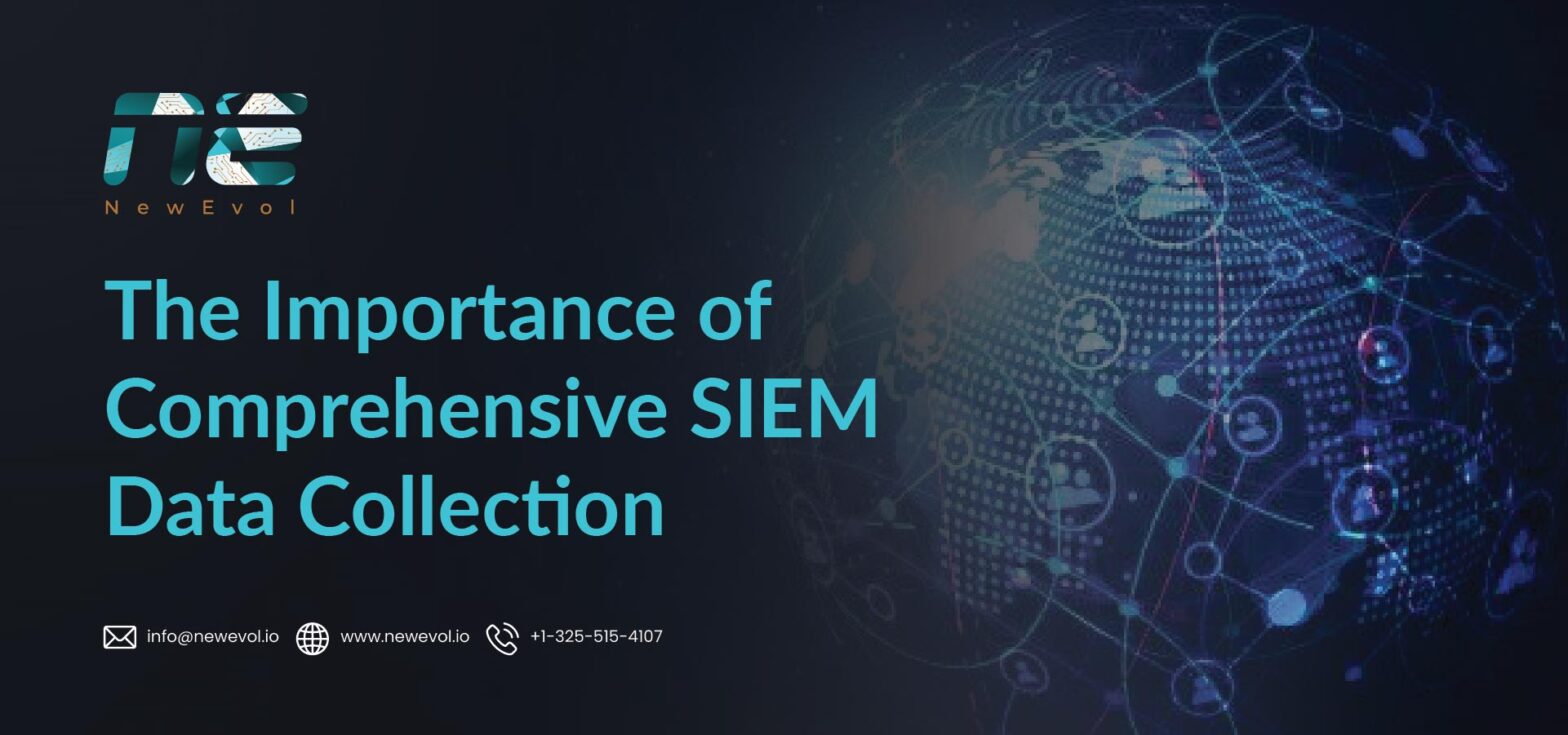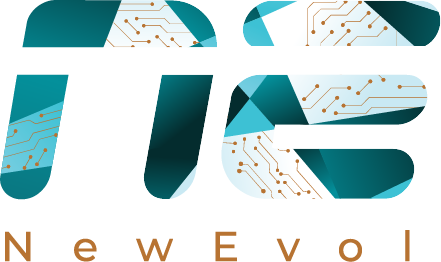The Importance of Comprehensive SIEM Data Collection

Cyber adversaries routinely exploit gaps, leveraging stealth, persistence, and obfuscation to evade detection. Security Information and Event Management (SIEM) systems are central to modern defense but they’re only as effective as the data they ingest. At NewEvol, we believe that comprehensive SIEM data collection is foundational to achieving a mature, proactive security posture. In this post, we explore why breadth and depth of data matter, what “comprehensive” means in practice, and how flawed collection strategies undermine effectiveness.
Why the Data Collection Baseline Matters
A SIEM is more than a log aggregator—it is the nerve center of a security operations ecosystem. It collects, normalizes, correlates, analyzes, alerts, and reports on security-relevant events across an enterprise. But if you feed it only a fraction of the relevant signals, you sacrifice context, reduce detection accuracy, and allow attackers to slip through.
Here are several core reasons why comprehensive data collection is a non-negotiable pillar:
1. Holistic visibility enables correlation across domains
A threat seldom limits itself to one system, one host, or one domain. Attackers may start with credential access on one endpoint, pivot laterally via internal servers, exfiltrate data through cloud services, or combine them with DNS tunnels to cover tracks. Without ingesting logs from endpoints, firewalls, application servers, identity systems, cloud services, and threat intel feeds, the SIEM cannot correlate a multi-stage chain and will likely miss the forest for the trees.
2. Behavioral and anomaly detection require rich baselines
User and Entity Behavior Analytics (UEBA) or anomaly-based detection depends on having historical, high-fidelity data. Without a broad data set, the system can’t build accurate baselines, making anomaly detection prone to both false positives and false negatives. NewEvol’s work with ArcSight, for example, involves building behavioral baselines and customizing anomaly rules to detect insider threats and subtle lateral movement.
3. Forensics and threat hunting demand depth in logs
When a compromise is detected—or suspected—security teams must reconstruct the attack timeline: “How did the attacker enter? What tools did they use? What did they touch? Where did they exfiltrate data?” This level of discovery depends on having fine-grained event logs (e.g., process creation, file access, DNS queries, command-line invocation, API calls) preserved over time. If your collection strategy discards “too much” detail or excludes critical sources, you lose that reconstruction capability.
4. Regulatory, compliance, and audit demands
Many regulatory frameworks (e.g., PCI-DSS, HIPAA, ISO 27001, NIST) demand audit trails, log retention, and proof of controls. A weak log collection policy can leave gaps that auditors will flag. SIEMs are often used to produce compliance-ready dashboards and reports that show adherence to required controls.
5. Reducing false positives through context
One of the greatest challenges in any detection system is alert fatigue. Many alerts are false positives due to missing context about whether an action is normal or suspicious. With richer data input (e.g., user roles, device posture, threat intelligence, vulnerability status), correlation engines can reduce noise and prioritize truly risky events.
6. Adaptive and intelligent systems need scale
Modern SIEM architectures are increasingly incorporating AI/ML, threat intelligence feeds, and user behavioral analytics. Such systems thrive on high-volume, high-velocity datasets to “learn” patterns and detect previously unknown tactics. NewEvol has explored how AI integration enhances traditional SIEM to detect stealthy or evolving threats. Without comprehensive data, these “learning” models starve for signal.
What “Comprehensive” Means in Practice
“Comprehensive” can be an ambiguous term, so let’s break it into practical dimensions—i.e., what data types, sources, and strategies SIEM teams should aim to cover. Below is a non-exhaustive but robust framework:
|
Data Dimension |
Key Sources / Examples |
Rationale |
|
Identity & Access |
Active Directory logs, single-sign-on systems, MFA logs, privileged access tools |
Track where credentials are used, when escalations occur, anomalous logins |
|
Endpoints & Hosts |
Endpoint Detection & Response (EDR), host logs (process creation, file access, registry), OS event logs |
Observe attacker tactics at host-level |
|
Network / Perimeter |
Firewalls, IDS/IPS, Network Flow, proxy logs, DNS, VPN gateways |
Monitor ingress/egress and lateral movement |
|
Applications & Databases |
Web server logs, application logs, database audit logs, APIs |
Detect abuses, injection, anomalous behaviors in applications |
|
Cloud / SaaS |
Access logs (IAM, S3, Azure/AWS logs), tenant logs, cloud service APIs |
See cloud-specific threats and exfiltration paths |
|
Vulnerability / Threat Intelligence |
Vulnerability scanner outputs, malware feeds, reputable intel feeds, threat actor indicators |
Enrich detections and risk scores |
|
Configuration & Change |
Configuration management systems, syslog from infrastructure, change management logs |
Capture drift, unauthorized changes, and insider threats |
|
User Behavior & Contextual |
Asset inventories, role definitions, endpoint hygiene, business context, geolocation, device health |
Add context to strengthen correlation |
To be truly comprehensive, organizations must consider not just which sources to ingest, but how (mode, fidelity, retention, enrichment) and when. Some best practices:
- Agent-based vs agentless collection: Certain sources require local agents to capture deep telemetry; others can be collected via APIs or syslog.
- Normalization and schema standardization: Different vendors produce logs in varied formats. You must normalize, parse, and assign consistent fields to make correlation possible.
- Retention and archive strategy: Not all logs can be kept in “hot” storage indefinitely; define tiered storage, data lifecycles, and archival strategies.
- Filter thoughtfully: While you strive for broad ingestion, blindly ingesting everything leads to excess noise. Smart filtering, sampling, or event suppression must be carefully applied.
- Enrichment pipelines: Enrich raw events with context (e.g., user role, device risk, threat intelligence, vulnerability scores) to improve correlation and decisioning.
- Feedback loops and tuning: Continually refine collection policies based on detection efficacy, false positives, and evolving threats.
Pitfalls of Inadequate or Partial Collection
Ignoring or under-investing in data collection isn’t a “feature gap” — it’s a strategic vulnerability. Some of the dangers include:
- Blind spots for attackers: Without logs from key systems, attackers may dwell undetected, perform lateral movement, or exfiltrate data without triggering alerts.
- Inability to link events: One-off detections (e.g., anomalous login) may be meaningless in isolation. Without broader context, correlation fails.
- Fragile detection logic: Many detection rules assume a certain data availability. If logs are missing or incomplete, those rules may never trigger—or worse, generate false negatives.
- Forensic gaps and legal exposure: After a breach, missing logs can prevent incident responders from proving cause, exposure, or liability.
- Audit and compliance failures: Gaps will be flagged in compliance reviews, exposing the organization to regulatory penalties or reputational harm.
- Inefficient SOC operations: Analysts will waste time chasing incomplete evidence, responding to noise, or rebuilding context manually.
Recent academic research underscores that even mature SIEM systems are vulnerable to rule evasion or coverage gaps if data ingestion is not rigorously managed. Furthermore, researchers working on SIEM rule optimization emphasize that redundant or overlapping rules only worsen alert fatigue when data quality is subpar.
The NewEvol Approach: Elevating SIEM through Strategic Data Ingestion
At NewEvol, our SIEM-as-a-Service and consulting practice (including for ArcSight, UEBA, and SOAR) anchors security outcomes on intelligent, high-fidelity collection strategies. Here is how we operationalize “comprehensive” in real-world deployments:
1. Data Mapping & Gap Analysis
Before SIEM deployment or optimization, we conduct a detailed data mapping workshop with stakeholders—CIOs, system owners, network/security teams—to map every source, log type, and priority. This ensures we don’t miss obscure or custom systems.
2. Connector & Parser Engineering
We build and maintain custom connectors and parsers (e.g., SmartConnectors, custom JSON/XML parsers) tailored to client systems, including legacy or niche applications. For ArcSight customers, NewEvol engineers optimize parser logic and correlation rules aligned to MITRE ATT&CK and compliance needs.
3. Behavioral & UEBA Tuning
We deploy UEBA models calibrated to client behavior profiles, refining thresholds and anomaly logic over time. This demands continuous feedback and data enrichment.
4. Data Retention & Tiering Policies
We assist organizations in defining retention tiers: hot storage (fast query) for recent data, warm storage for mid-term, and archival/immutable storage for long-term forensic purposes.
5. Intelligence Enrichment & Threat Feeds
Raw logs are enriched with threat intelligence, vulnerability scanners, asset health, geolocation, and role-based metadata. This enrichment improves correlation precision and reduces false positives.
6. Ongoing Tuning & Rule Optimization
SIEM systems must evolve. We periodically review rule effectiveness, drop outdated rules, consolidate redundancies, and tune thresholds. This ensures that collection continues to drive value, not overhead.
7. Bridging Detection & Response with SOAR
In configurations where SOAR is layered atop SIEM, we automate triage, investigation, containment workflows, and alert response playbooks—closing the detection-to-action loop.
Through this disciplined, customer-tailored approach, NewEvol helps enterprises transform SIEM from a tool into a strategic capability.
Best Practices & Recommendations
To help organizations sharpen their own SIEM collection strategies, here are actionable recommendations:
1. Start wide, then refine
In early phases, err on the side of overcollection; monitor usage, noise, and value. Over time, suppress low-value logs and optimize performance.
2. Measure coverage and signal-to-noise
Continuously measure how many alerts or detections arose from each log source. If a source never contributes value, reevaluate its ingestion cost-benefit.
3. Stay aligned with attack frameworks
Use frameworks like MITRE ATT&CK to benchmark detection coverage. Ask: for each tactic or technique we care about, do we have the right logs to see it?
4. Iterate with red-teaming and threat emulation
Run adversary simulation or purple-team exercises. See where your logs fail to capture an attack chain; then plug those gaps.
5. Implement retention guardrails early
Ensure that your retention strategy supports post-incident investigations, even for low-priority logs.
6. Invest in enrichment and context
Logs without context have limited utility. Include metadata (user roles, device risk scores, location, network zones) to drive intelligent correlation.
7. Govern collection policies
Document what is collected, why it is collected, who has access, and how long it is retained—this helps with audit, privacy, and risk controls.
End Note
In cybersecurity, visibility is power and comprehensive SIEM data collection provides the raw material for meaningful detection, correlation, response, and resilience. A lack of visibility is not merely a minor gap, it is a strategic weakness adversaries exploit.
At NewEvol, we view data collection as the foundation upon which all advanced detection and response capabilities are built. Without a robust ingestion and enrichment strategy, even the most sophisticated analytic or automation layers will struggle to perform. With it, SIEM becomes less of a passive monitor and more of a proactive, intelligent, strategic security platform.
If you’d like to discuss how NewEvol can help architect or optimize your SIEM data collection framework, we’d be happy to dive deeper—tailored to your environment, objectives, and risk profile.
FAQs
1. What is the importance of SIEM?
SIEM centralizes and analyzes security data to detect threats, reduce response times, and support compliance.
2. What is data collection in SIEM?
Data collection is the process of gathering logs and events from systems, applications, and networks for analysis.
3. Why is a SIEM necessary for an organization’s log collection?
A SIEM ensures all relevant logs are captured, correlated, and stored, enabling timely threat detection and forensic investigations.
4. What is the purpose of data aggregation in SIEM?
Data aggregation consolidates logs from diverse sources to provide unified visibility, simplify analysis, and enhance detection accuracy.

